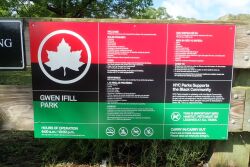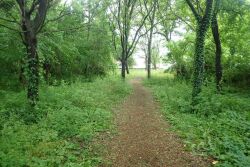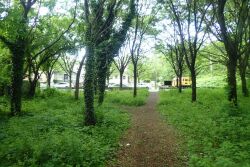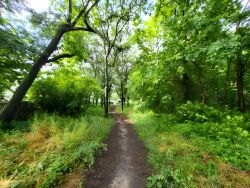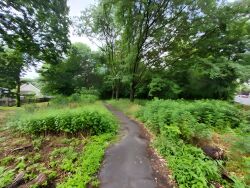Gwen Ifill Park
Railroad Park
This park takes its name from the Long Island Railroad (LIRR), whose tracks form the area’s southwest boundary. The railroad began with the incorporation of the Brooklyn & Jamaica Railroad Company on April 25, 1832. The enterprise originally planned to lay ten miles of track connecting Brooklyn and Jamaica before expanding eastward to Greenport, the northeastern tip of Long Island. There, passengers would connect with a ferry to Stonington, Connecticut where the Norwich & Worcester Railroad would carry them to Boston. The route, devised by Mayor of East New York, B.D. Douglass, would cut the 16-hour trip to Boston to 11-hours. The New York State Legislature chartered the Long Island Railroad Company on April 24, 1834 and track construction immediately began, with the initial ten-mile section completed on April 18, 1836.
By March of 1837, the LIRR had reached ten miles east of Jamaica to the current town of Hicksville, named after the second president of the LIRR, Valentine Hicks. The economic depression of 1837 temporarily caused construction to halt, but by 1841, the LIRR had reached Farmingdale in Suffolk County. On July 27, 1844, the first train made the three and a half hour trip from Brooklyn to Greenport.
By 1850, however, a direct rail line from New York to Boston opened, leaving the LIRR’s ferry route obsolete. To stay in business, the railroad evolved into a passenger service for Long Island residents, an objective that was made difficult by the fact that the LIRR’s main line ran down the middle of the Island while the majority of the population lived on the coast.
As a result, throughout the 1860s and 70s, the LIRR faced competition from other railroads seeking to capitalize on the company’s lack of service to coastal communities. The South Side Railroad of Long Island, Brooklyn & Rockaway Beach Railroad, New York & Hempstead Plains Railroad, Central Railroad of Long Island, New York & Flushing Railroad, and Flushing & North Side Railroad, among others, were formed in response to this problem. The railroads were not financial successes, however, and were all consolidated into the LIRR by company president Conrad Poppenhusen in 1875.
In 1900 the Pennsylvania Railroad bought the LIRR for $6 million and constructed tunnels across the East River, establishing a rail link from Long Island to Penn Station in Manhattan. This event, perhaps more than any other, engendered the suburban nature of the island seen today. The peak year of the LIRR came in 1929 when the railroad carried 118,888,288 passengers. With the expansion of Queens subways and increased automobile usage in the following years, ridership decreased to 70 million by 1940. In 1966, The LIRR was purchased by the State of New York and has since been operated under the jurisdiction of the Metropolitan Transportation Authority.
The City of New York acquired the land for Railroad Park on September 27, 1962 from the Rochdale Village limited-profit housing project. Additional land for the park was acquired through condemnation on December 30, 1963. In 1999, Parks installed a replacement fence along Garrett Street and started a landscape operation on the 129th Street side of the park. Several other recent improvements to the park have come through the efforts of the Railroad Park Garden Club. The group, along with a local Boy Scout troop, helps Parks add plantings and groundcover to the park. The Garden Club also sponsors clean up days and other community events to increase awareness of Railroad Park as a neighborhood resource.
Check out your park's Vital Signs
Clean & Safe
Green & Resilient
Empowered & Engaged Users
Share your feedback or learn more about how this park is part of a
Vital Park System

